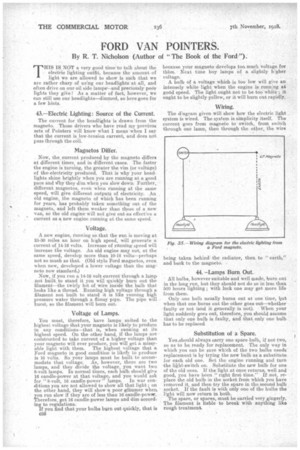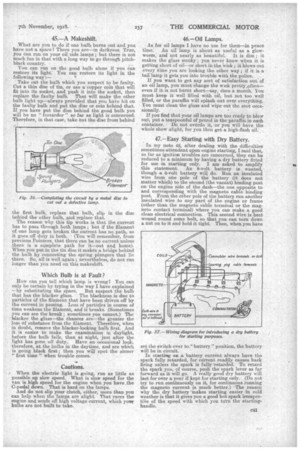FORD VAN POINTERS.
Page 16

Page 17

If you've noticed an error in this article please click here to report it so we can fix it.
By R. T. Nicholson (Author of "The Book of the Ford").
THIS IS NOT a very good time to talk about the eleCtric lighting outfit, because the amount of light we are allowed to show is such that we are rather chary of using our headlights-at all, and often drive on our oil side-lamps'---and preciously poor lights they gibe! As a matter of fact, however, we can still use our headlights—dim-ned, so here goes for a few hints.
43.—Electric Lighting: Source of the Current.
The current for the headlights is drawn from the magneto. Those drivers who have read my previous sets of Pointers will know what I mean when I say that the current is low-tension current, and does not pass-through the cc;11.
Magnetos Differ.
, Now, the current produced by the magneto differs at different times, and in different eases. The faster the engine, is turning, the greater the vim (or voltage) of theeelectricity produced. That is why your headlights shine brightly when you arc running at a good pace and 4hy they dim when you slow down. Further, different magnetos, even when running at the same speed, will give different outputs of electricity. An old engine, the magneto a which has been running for years, has probably taken something out of the magnets, and left them weaker than those of a new van, so the old engine Will not give out-as effective a current as a new engine running at the same speed.
Voltage.
A new engine, running so that the van is moving at 25-30 miles an hour on high speed, will generate a, current of 14-16 volts. Increase of running speed will increase the voltage. An old engine may not, at the same speed, develop more than 10-12 volts—perhaps not so much as that. (Old style Ford magnetos, even when new, developed a lower voltage than the magneto now standard.) Now, if you run a 14-16 volt current through a lamp not built to stand it you will quickly burn out the filament—the twirly bit of wire inside the bulb that looks like a thread. Running high vyltage through a filament not built to stand it is like running high pressure water through a flimsy pipe. The pipe will burst, so the filament will burn out.
Voltage of Lamps.
You must, therefore, have lamps suited to the highest voltage that your magneto is likely to produce in any conditions—that is, when running at its highest speed. On the other hand, if the lamps are constructed to take current of a higher voltage than your magneto will ever produce, you will get a miserable light with them. The highest voltage that a Ford magneto in good condition is like-1'y to produce is 16 volts. So your lamps must be built to accommodate that voltage. As, however, there are two lamps, and they divide the voltage, you want two 8-volt lamps. In normal times, each bulb should give 16 candle-power at that voltage,. arid you would ask ' for "8-volt 16 candle-power" lamps. In war conditions you are not allowed to show all that light ; on the other hand, they will show -a poor glimmer when. you run slow if they are of less than 16 candle-power. Therefore, get 16 candle-power lamps and dim according to regulations. If you find that your bulbs burn outquickly, that is 036 because your magneto develops too, much voltage for them. Next time buy lamps of a slightly higher voltage. A bulb of a voltage which is too low will give an intensely white light when the engine is running at good speed. The light ought riot to be too white; it ought to be slightly yellow, or it will burn out rapidly.
Wiring.
The d.iagram given will show how the electric light system is wired. The system is simplicity itself. The current goes from magneto to switch, from switch through one lamp, then through the other, the wire being taken behind e the radiator, then to "earth," and bade to the magneto.
44. —Lamps Burn Out..
All bulbs, however suitable and well made, burn out in the long run, but they should not do so in less than 500 hours lighting ; with luck one may get more life from them.
Only one bulb usually burns out at one time, but when that one burns out the other goes out—whether faulty or not (and it generally is not). When your light suddenly goes out, therefore, you should assume that only one bulb is faulty, and that only one bulb has to be replaced
Substitution of a Spare.
You.should always carry one spare bulb, if not two, BO as to be ready for replacement. The only way in which you can be sure which of. the two bulbs needs replacement is by trying the new bulb as a substitute for -each old one. Set the engine running and turn the likht-switch on. . Substitute the new bulb for one of the old ones. If the light at once returns well and good, you have been " right first time," if-not, replace the old bulb in the socket from which you have removed it, and then try the spare in the second bulb socket. If the fault is with only one of the bulbs the light will now return in both. The spare, or spares, must he carried very gingerly. The filament is liable to break with anything like rough treatment.
45.—A Makeshift
What are you to do if one bulb burns out and you have not a spare? There you are—in darkness. True, you can run on your oil-side lamps ; but there is not much fun in that with a long way to go through pitchblack country.
You. can run on the good bulb alone if you can restore its light: You can restore its light in the following way:—
Take out the bulb which you suspect to be faulty. Cut a thin disc of tin, or use a copper coin that will fit into its socket, and push it into the socket, then replace the faulty bulb. • That will make the other bulb light up—always provided that you have hit on the faulty bulb and put the disc or own behind that. If you have put the disc behind the good bulb you will be no " forrarder " so far as light is concerned. Therefore, in that case, take but the disc from behind
the first bulb, replace that bulb, slip in the disc behind the other bulb, and replace that. The reason why this tip works is that the current has to pass through both lamps ; but if the filament of one lamp gets broken the current has no path, so it goes off duty in both. (You will remember, from previous Pointers, that there can be no current unless there is a complete path for it—out and home). When you put in the tin disc it makes a bridge behind the bulb by connecting the spring plungers that lie there. So, all is well again ; nevertheless, do not run longer than you need on this makeshift.
Which Bulb is at Fault?
How can you tell which lamp is wrong? You can only be certain by trying in the way I have explained —by substituting the spare. But suspect the bulb that has the blacker glass. The blackness is due to particles of the filament that have been driven off by the current in passing. Loss of particles in course of time weakens the filament, and it breaks. (Sometimes you can see the break ; sometimes you cannot.) The blacker the glass—the chances are—the greater the loss of substance from the filament. Therefore, when in doubt, remove the blacker-looking bulb first. And it is easier to make the examination in daylight, before the bulb fails, than at night, just after the light has gone off duty. Have an occasional look, therefore, at the bulbs in the daytime, and see which is going black first ; then you will spot the sinner "first time" when trouble comes.
Cautions.
When the electric light is going, run as little as possible on slow speed. What is slow speed for the van is high speed for the engine when you have,the C-pedal down. That is hard on the lamps. And do not slip your clutch, either, more than you can help when the lamps are alight. That races the engine and sends off high voltage current, which your bulbs are not built to take.
THE COMMERCIAL MOTOR 46.—Oil Lamps.
As for oil lamps I have no use for them—in peace time. An oil lamp is about as useful as a glowworm, and not nearly as beautiful, It is dim ; it makes the grass smoky ; you never know when it is getting short of oil—or short in the 'wick ; it blows out every time you are looking the other way ; if it is a tail lamp it gets you into trouble with the police.
If you want to get any sort of satisfaction out of an oil lamp, you must change the wick prettynf ten— even if it is not burnt short—say, once a month. You must keep it well filled with oil, but not too well filled, or the paraffin will splash out over everyithing. You must clean the glass and wipe out the soot occasionally.
If you find that your oil lamps are too ready to blow out, put a teaspoonful of petrol in the paraffithin each container. Do not overdo it, or you will have the whole show alight, for you then get a, high-flash oil.
47.—Easy Starting with Dry Battery.
In my note 42, after dealing with the difficulties sometimes attendant upon engine starting, I said that, so far as ignition troubles are concerned, they can be reduced to a minimum by having a dry battery fitted for use in starting only. I am asked to amplify this statement. An 8-volt battery is wanted., though a 6-volt battery will do. Run an insulated wire from one pole of the battery (it does not matter which) to the second (the vacant) binding post on the engine side of the dash—the one opposite to and corresponding with the magneto cable binding post. From the other pole of the battery run another insulated wire to any part of the engine or frame (other than the magneto cable terminal or the magneto contact terminal) where you can make a good clean electrical connection. This second wire is best wound round some bolt, so that you can turn down a nut on to it and hold it tight. Then, when you have set the switch over to." battery" position, the battery will be in circuit.
In starting on a battery current always have the , spark fully retarded, for current readily causes back firing unless the spark is fully retarded. To retard the spark yeti, of course' push the spark lever as far forward as it will go. A really good dry battery will last for over a year if kept for starting only. (Do not try to run continuously, on it, for continuous running the magneto current is much better.) The reason why the dry battery makes starting easier in cold weather is that it gives you a good hot spark irrespectiir.e of the speed with which you turn the startinghandle.






















